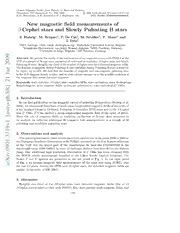
New magnetic field measurements of beta Cephei stars and Slowly Pulsating B stars PDF
Preview New magnetic field measurements of beta Cephei stars and Slowly Pulsating B stars
Cosmic Magnetic Fields: from Planets, to Starsand Galaxies Proceedings IAU Symposium No. 259, 2008 (cid:13)c 2008International AstronomicalUnion K.G. Strassmeier, A.G. Kosovichev & J. Beckmann, eds. DOI:00.0000/X000000000000000X New magnetic field measurements of β Cephei stars and Slowly Pulsating B stars S. Hubrig1, M. Briquet2, P. De Cat3, M. Sch¨oller4, T. Morel5 and I. Ilyin6 1ESO, Santiago, Chile; email: [email protected]; 2Katholieke Universiteit Leuven,Belgium; 3Koninklijke Sterrenwacht van Belgi¨e, Brussel, Belgium; 4ESO,Garching, Germany; 5Universit´ede Li`ege, Belgium; 6AIPPotsdam, Germany 9 0 Abstract.WepresenttheresultsofthecontinuationofourmagneticsurveywithFORS1atthe 0 VLTofasampleofB-typestarsconsistingofconfirmedorcandidateβCepheistarsandSlowly 2 PulsatingBstars.RoughlyonethirdofthestudiedβCepheistarshavedetectedmagneticfields. n ThefractionofmagneticSlowlyPulsatingBandcandidateSlowlyPulsatingBstarsisfoundto a be higher, up to 50%. We find that the domains of magnetic and non-magnetic pulsating stars J intheH-Rdiagram largely overlap,andnoclearpictureemergesastothepossibleevolutionof 1 themagnetic field across the main sequence. 2 Keywords.stars:variables:βCephei,stars:variables:SPBs,stars:oscillations,stars:Hertzsprung- ] Russell diagram, stars: magnetic fields, techniques:polarimetric, stars: individual (ξ1 CMa) R S . h 1. Introduction p - InourfirstpublicationonthemagneticsurveyofpulsatingB-typestars(Hubriget al. o 2006),weannounceddetectionsofweakmeanlongitudinalmagneticfieldsoftheorderof r t afewhundredGaussin13SlowlyPulsatingB(hereafterSPB)starsandintheβ Cephei s a star ξ1 CMa. ξ1CMa showed a mean longitudinal magnetic field of the order of 300G. [ Since the role of magnetic fields in modeling oscillations of B-type stars remained to be studied, we collected additional 98 magnetic field measurements in a sample of 60 1 v pulsating and candidate pulsating stars. 9 1 3 2. Observations and analysis 3 . Thespectropolarimetricobservationshavebeencarriedoutintheyears2006to2008at 1 theEuropeanSouthernObservatorywithFORS1mountedonthe8-mKueyentelescope 0 9 of the VLT. For the major part of the observations we used the GRISM600B in the 0 wavelengthrange3480–5890˚AtocoverallhydrogenBalmerlinesfromHβ totheBalmer : jump. One additional high resolution observation of ξ1CMa has been obtained with v i the SOFIN echelle spectrograph installed at the 2.56m Nordic Optical Telescope. The X Stokes I and V spectra are presented in the left panel of Fig. 1. In the right panel r of Fig. 1 we present magnetic field measurements of the same star using FORS1 over a the last 4.4years. Among the SPBs and βCephei stars, the detected magnetic fields are mainly of the order of 100–200G. 3. Discussion Roughly one third of the βCephei stars have detected magnetic fields: Out of 13 βCepheistarsstudiedto datewithFORS1,fourstarspossessweakmagnetic fields,and 119 120 S. Hubrig et al. ux 00..56 440500 ξ1 CMa d fl 0.4 malize 0.3 G] 350 Nor 0.2 > [all300 V/I 00..01 <Bz250 10x -0.1 200 -0.2 -0.3 150 400 600 800 1000 1200 1400 1600 MJD-53000 46714672467346744675467646774678467946804681 Heliocentric wavelength (Angstrom) Figure 1. Left panel: High-resolution (R≈30000) SOFIN polarimetric spectrum of ξ1CMa. A clearZeemanfeatureisdetectedatthepositionoftheunblendedlineOIIλ4676.2.Rightpanel: Magnetic field measurements with FORS1 of ξ1CMa overthelast 4.4 years out of the sample of six suspected βCephei stars two show a weak magnetic field. The fractionof magneticSPBs andcandidate SPBsis found to be higher:roughlyhalfof the 34 SPB stars have been found to be magnetic and among the 16 candidate SPBs, eight stars possess magnetic fields. About a dozen pulsating stars discussed in our previous study Hubrig et al. (2006) have been subsequently observed by Silvester et al. (this proceedings) with ESPaDOnS at CFHT and NARVAL at TBL. The interesting result is that they could confirm our previousnon-detectionsintenβCepheiandSPBstarsbutfailedtodetectweakmagnetic fields in the other four magnetic SPB stars selected from our study. On the other hand, as has been shown at the present meeting by Henrichs et al. (this proceedings) who confirmedourdetectionofamagneticfieldintheB3Vstar16Peg,theintegratedZeeman features obtained from the application of a cross-correlationmethod, the Least-Squares Deconvolution, are extremely weak for ∼100G fields. This means, that even using high- resolutionspectrographslikeESPaDOnSorNarval,veryhighsignal-to-noiseobservations are mandatory to be able to detect magnetic fields in hot stars where only a limited number of metal lines are suitable for the measurements. In an attempt to understand why only a fraction of the pulsating stars exhibit mag- netic fields, we studied the position ofmagnetic andnon-magnetic pulsating stars in the H-R diagram. We find that their domains in the H-R diagram largely overlap, and no clear picture emerges as to the possible evolution of the magnetic field across the main sequence. It is possible that stronger fields tend to be found in stars with lower pulsat- ing frequencies and smaller pulsating amplitudes. A somewhat similar trend is found if we consider a correlation between the field strength and the vsini-values, i.e. stronger magnetic fields tend to be found in more slowly rotating stars. References Hubrig,S., Briquet, M., Sch¨oller, M., et al. 2006, MNRAS,369, L61
